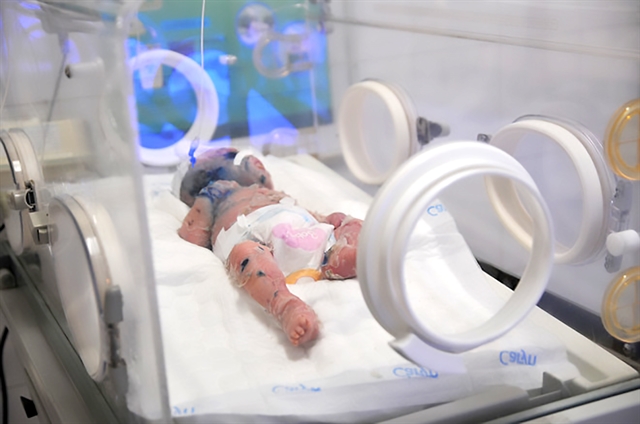 Society
Society

 |
| A two-month-old boy with Harlequin ichthyosis is treated at Đồng Nai Children’s Hospital. The disease is an extremely rare genetic disorder in which the skin hardens and forms large, diamond-shaped scales. VNA/VNS Photo Lê Xuân |
HÀ NỘI While more than half of people living with rare diseases in Việt Nam are children, access to rare disease treatment remains limited due to high costs and a lack of comprehensive health insurance coverage.
According to the Ministry of Health, Việt Nam has about six million people living with rare diseases, 58 per cent of whom are children.
Data shows that an alarming 30 per cent of children with rare diseases die before the age of five.
Rare diseases often include metabolic disorders, genetic conditions and immune and neurological disorders.
Although around 6,000 rare diseases have been recorded globally, affecting more than 300 million people, diagnosis and treatment remain limited.
Patients face three major difficulties: diagnosis, treatment and accessing medicines.
Because symptoms are often atypical and easily confused with common illnesses, diagnosing rare diseases is usually lengthy and complex.
A lack of medical expertise and advanced testing technologies further complicates the process.
Global statistics show that 80 per cent of rare diseases are genetic in origin, but only about 200,000 people are correctly diagnosed.
According to Dr Nguyễn Thị Thanh Hương, deputy director of Children’s Hospital 1 in HCM City, only about 10 per cent of rare diseases currently have available treatments. This makes the treatment process challenging, not just medically but also financially.
At a scientific seminar organised by the Ministry of Health and the Việt Nam Medical Association in Hà Nội, Tống Thị Song Hương, former director of the Department of Health Insurance under the Ministry of Health, said: “The treatment burden of rare diseases is five to 10 times higher than that of common illnesses.”
A US study conducted in 2019 revealed that treating 15.5 million people with 379 rare diseases cost up to US$997 billion, including hospitalisation, treatment drugs and non-medical and indirect costs.
Dr Hương said that since 2017, Children’s Hospital 1 managed more than 500 paediatric rare disease cases. Each year, the hospital spends nearly VNĐ40 billion on medicines for these patients, with some treatment courses costing as much as VNĐ80 billion for a single round.
However, if children are treated, it can change their entire lives, not only significantly improving their health and quality of life but also giving them the chance to integrate, study and develop like other healthy children, she said.
Improving access to medicine
Associate Professor Nguyễn Thị Xuyên, President of the Vietnam Medical Association, said that due to their rarity and complexity, rare diseases present major challenges for diagnosis and treatment.
Only about 5 per cent of rare diseases have drugs approved by the US Food and Drug Administration (FDA). High treatment costs mean most patients cannot afford care without support from the Government budget or social organisations, especially for long-term therapies.
Some rare diseases already have advanced treatments abroad targeting their genetic causes, but these therapies are not yet approved for use in Việt Nam. Even when drugs are available, patients often face difficulties in accessing them due to excessive costs and limited insurance coverage, she said.
For instance, while Việt Nam’s health insurance system fully covers the cost for children under six with Pompe disease and 30 per cent of the cost for older children, many other rare disease drugs remain outside the insurance reimbursement list. In reality, some patients must give up treatment because they cannot access drugs or must rely on unsustainable international humanitarian programmes.
Dr Nguyễn Khánh Phương, director of the Health Strategy and Policy Institute under the Ministry of Health, said 92 countries already have policies on rare disease drugs, with some enacting specific laws such as orphan drug laws. The Netherlands, Australia and Belgium have established special funds to support rare disease patients, while the US Orphan Drug Act promotes research and access to rare medicines.
Drawing from international experience, Dr Phương suggested that Việt Nam should develop comprehensive policies on rare disease management to improve medicine access. This includes issuing treatment guidelines, expediting drug registration and licensing and creating financial mechanisms and reimbursement schemes for patients.
Positive signs
The Ministry of Health has established the Steering Committee for Strengthening Rare Disease Management in Việt Nam, headed by Deputy Minister of Health Professor Trần Văn Thuấn along with participation from policymakers, the Vietnam Medical Association and specialists across various fields.
According to Deputy Director of the Health Insurance Department Vũ Nữ Anh, rare disease drugs proposed for insurance reimbursement will receive certain priorities.
Budget impact assessments are required for new drugs, but for rare disease drugs, cost-effectiveness assessments may not be mandatory. For drugs with proposed higher reimbursement rates, authorities will review applications and assess budget impact for feasibility, she said. VNS
What are rare diseases?Genetic counseling specialist at Vinmec Institute of Stem Cell Research and Gene Technology Dr Đỗ Phước Huy said that according to the European Union, a disease is classified as rare when it affects fewer than one in 2,000 people based on the global population.Statistics show that eight out of 10 rare diseases are genetic in origin. These conditions are usually chronic, significantly impacting quality of life and even leading to death.Rare diseases include uncommon cancers, such as childhood cancers, male breast cancer, haemolytic anaemia and Down syndrome. Other causes of rare diseases may include congenital infections and autoimmune disorders.




